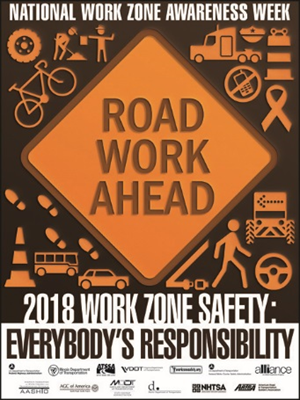2018 National Work Zone Awareness Week, April 9-13 – “Work Zone Safety: Everybody’s Responsibility”
Construction companies are committed to ensuring the safety of their workers and the traveling public. Roadway work zones use a variety of warning systems, barriers, flaggers, and other traffic control measures to make sure that drivers and work zones stay separated, but it just takes a moment of distraction for an incident to happen that will change lives forever.
Work zones play a key role in maintaining and upgrading our nation’s roadways. Unfortunately, daily changes in traffic patterns, narrowed rights-of-way, and other construction activities often create a combination of factors resulting in crashes, injuries, and fatalities.
Work zone incidents impact everyone. Every year more than 600 people are killed in roadway work zones. In addition to vehicular crashes and fatalities, the leading cause of death in the road and bridge construction sector are run overs, back overs, and falls. Simply put: drivers, passengers, and construction workers are all at risk.
National Work Zone Awareness Week (NWZAW) is April 9-13 to bring national attention to motorist and worker safety and mobility issues in work zones. Since 1999, FHWA has worked with the American Association of State Highway and Transportation Officials (AASHTO) and the American Traffic Safety Services Association (ATSSA) to coordinate and sponsor the event. Over the years, other transportation partners have joined the effort.
The “WatchForUs” campaign (www.WatchFor.Us) includes a short film entitled “One Moment Can Save a Life” that depicts a fictionalized story on the impacts of distracted driving to one family, as well as real-life testimonial videos from industry figures whose colleagues and friends have been directly affected by work zone incidents.
It’s important for everyone to do their part to improve work zone safety. Work zone safety is everybody’s responsibility. Your driving habits can directly help—or harm—the well-being of other motorists, cyclists, workers, and pedestrians, including you.
- Drivers, bikers, motorcyclists, and pedestrians should always be alert, obey traffic laws and signs, and pay attention to their surroundings.
- Passengers should always buckle up, act responsibly, and avoid distracting the driver.
- Field workers must always implement safety best practices when actively working in construction zones.
- Emergency responders must be able to respond to and secure crash locations.
- Police and courts are responsible for enforcing traffic and work zone laws.
- Local and state governments should promote safe roads and increase public awareness about work zone safety.
Tips for Driving Safely in and Around Work Zones
- Know Before You Go. Check your phone apps, agency websites, and the radio for the latest traffic information to ensure a safe and timely trip.
- Wear Your Seatbelt. It is your best defense in a crash.
- Expect the Unexpected. Work zones change often. The area you drove through yesterday may look different today.
- Avoid Distractions. Distracted driving in a work zone can have deadly consequences. Put down your phone and keep your eyes on the road.
- Pay Attention to Other Drivers. Narrowed traffic patterns provide less ability to maneuver around other vehicles safely. Paying attention can prevent the need for evasive actions in work zones.
- Don’t Speed or Tailgate. Keep a safe distance from the vehicle ahead of you and don’t speed. Tailgating and speeding lead to crashes with other vehicles and field workers.
- Obey Road Crews and Signs. Flaggers know how best to move traffic safely in work zones. The warning signs are there to help you and other drivers move safely.
- Be Patient and Stay Calm. Work zone crew members are working to improve the road and make your future drive better. Stay calm and drive safely.


